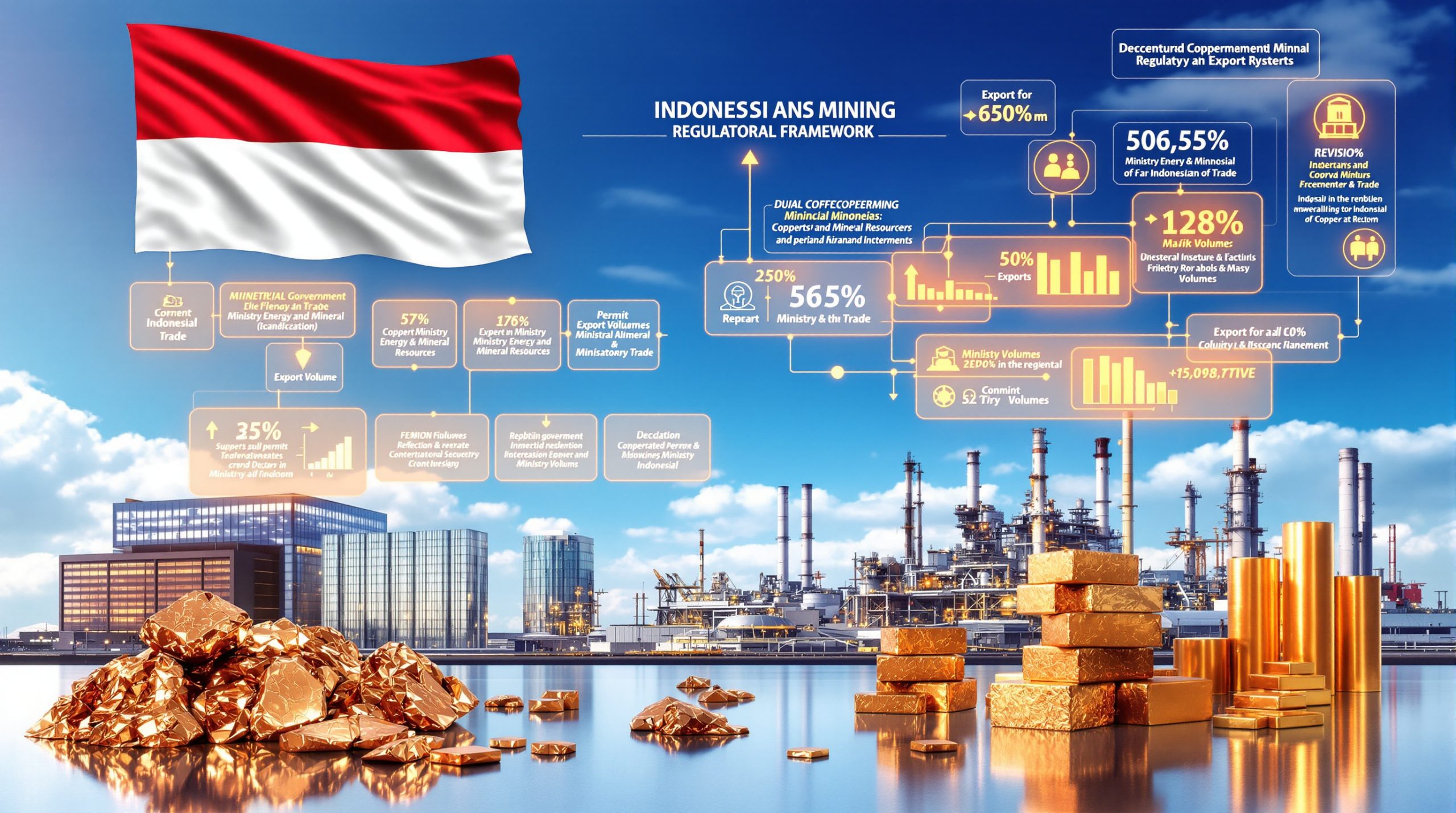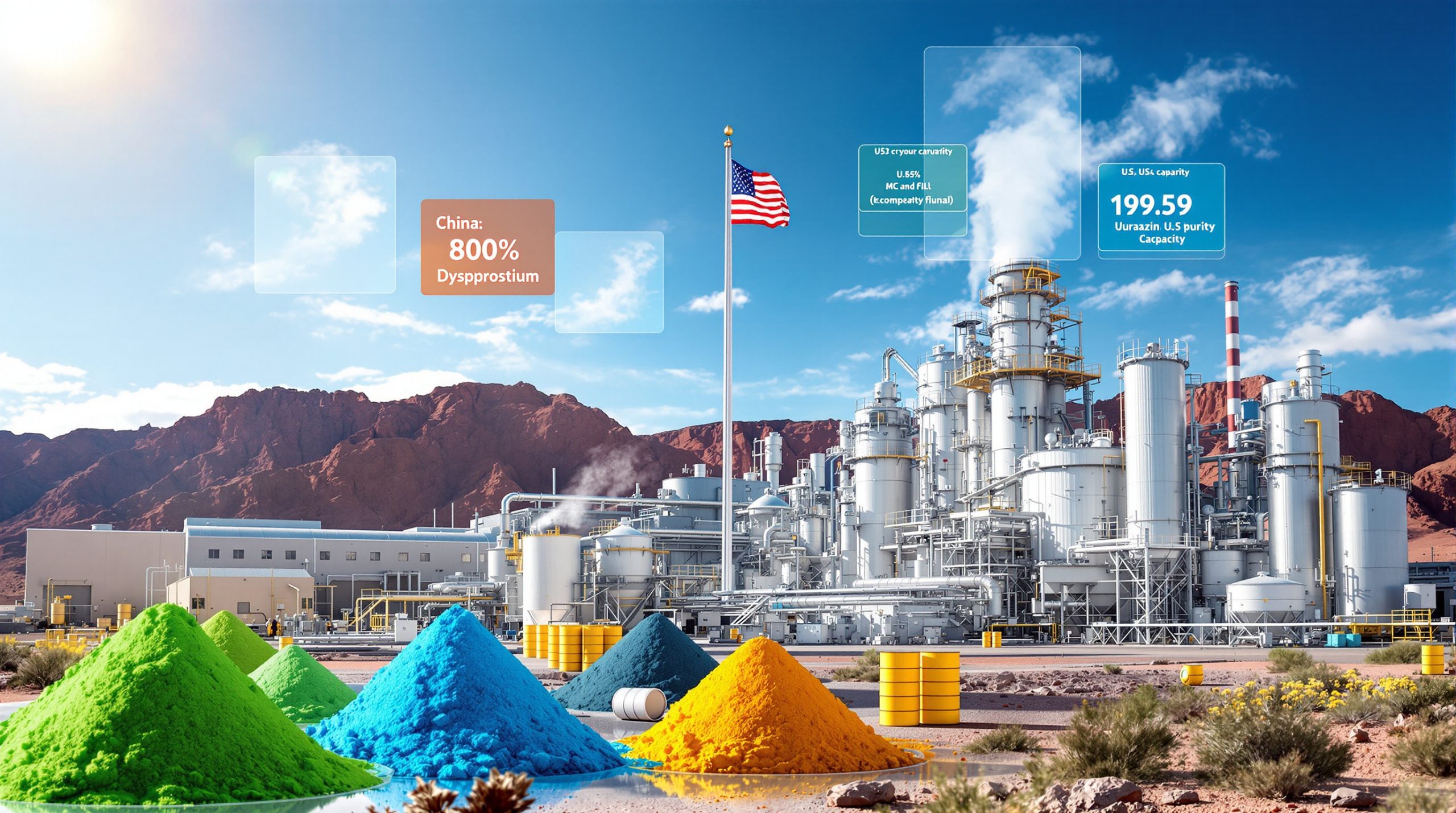What is the Pentagon's Critical Minerals AI Program and Why Was it Transferred?
The Pentagon's groundbreaking artificial intelligence program for critical minerals has found a new home at the Critical Minerals Forum (CMF), a strategic move that signals a significant shift in America's approach to securing vital mineral supply chains. Originally launched in late 2023 as the Open Price Exploration for National Security AI metals program, this initiative represents a direct response to China's long-standing dominance in critical mineral markets.
The transfer, completed in May 2025, moves control from direct military oversight to a specialized non-profit organization better positioned to coordinate between private industry, defense contractors, and government interests. This structural change maintains the program's core mission: creating transparent pricing mechanisms that exclude potential market manipulation while fostering resilient supply chains for materials essential to defense and technology sectors.
The Strategic Transfer to the Critical Minerals Forum
The Pentagon's decision to transfer the AI program to the Critical Minerals Forum reflects a sophisticated approach to mineral security. Rather than keeping such valuable technology within military confines, this move enables broader industry participation while maintaining government backing through continued Defense Advanced Research Projects Agency (DARPA) funding.
"The CMF's strategy is to facilitate supply deals with Western mines, fundamentally altering traditional metal trading methods," explains Rob Strayer, CMF President and former U.S. diplomat who now leads this critical initiative. This approach acknowledges that mineral security requires coordination across multiple sectors – from mining to manufacturing to defense.
DARPA's commitment includes guaranteed financial support until at least 2029, with intellectual property transfer scheduled for 2027. This extended timeline ensures stability while the program builds credibility and establishes itself as an industry standard for critical mineral pricing and supply chain development.
How Does the Critical Minerals Forum Operate?
The Critical Minerals Forum has established itself as a powerful coordinating body with 30 founding members spanning diverse sectors of the mineral supply ecosystem. This carefully structured membership includes mining companies like South32 (copper) and MP Materials (rare earths), manufacturers such as Volkswagen, defense contractors including RTX (formerly Raytheon Technologies), and strategic investment entities focused on mineral security.
This membership diversity is no accident – it creates a comprehensive view of the entire supply chain from extraction to end-use, enabling the Forum to identify bottlenecks, opportunities, and vulnerabilities that might otherwise remain hidden within isolated industry segments.
Funding and Operational Framework
The CMF operates with a robust operational structure backed by DARPA funding secured until 2029. This long-term financial commitment provides crucial stability for an initiative that aims to fundamentally transform critical mineral markets – a process that cannot happen overnight.
The planned intellectual property transfer in 2027 represents another strategic milestone, gradually shifting ownership of the AI technology from government to private hands. This transition acknowledges that while government can incubate such initiatives, industry-led coordination may ultimately prove more agile and responsive to market conditions.
Beyond funding, the CMF's operational framework includes specialized working groups focused on specific mineral categories, technical committees overseeing AI model development, and industry engagement teams working to expand participation beyond the founding members.
What Technology Powers the Critical Minerals AI Program?
At the core of the Critical Minerals Forum's work is a sophisticated artificial intelligence system that represents a significant advancement in commodity market analysis. This AI model has been trained on more than 70 mining-related datasets, giving it unprecedented insight into the complex factors that influence mineral prices and availability.
Unlike traditional pricing mechanisms that rely heavily on spot market transactions (which can be manipulated by dominant players), this AI system incorporates a broader range of inputs including production costs, geopolitical risk indicators, and supply-demand fundamentals while deliberately excluding data from Chinese-dominated exchanges like the Shanghai Metal Market.
AI Model Capabilities and Data Infrastructure
The system utilizes advanced machine learning algorithms to filter out potential market distortions and establish what it considers "fair market prices" for critical minerals. It does this by identifying patterns that might indicate market manipulation and creating alternative pricing benchmarks that better reflect actual production economics.
"The model identifies fair prices by isolating manipulation signals from genuine market fundamentals," according to a DARPA official involved in the program's development. This capability is particularly valuable for minerals where transparent price discovery has historically been difficult due to concentrated market control.
The AI model's most distinctive feature is its forward-looking capability, providing 5-10 year price trend forecasts that can guide long-term investment decisions in mining projects – addressing a fundamental challenge in developing new mineral sources which typically require years of development before production begins.
Applications for Supply Chain Management
Beyond mere price prediction, the CMF's AI system serves multiple strategic functions in strengthening mineral supply chains:
- Investment confidence: By providing more stable price projections, the system helps mining companies secure financing for new projects, as evidenced by South32's recent investment in an Arizona copper mine guided by CMF data
- Supply deal facilitation: The model creates confidence between Western miners and manufacturers, reducing negotiation times (by 30% according to Volkswagen's procurement head) and enabling longer-term contracts
- Alternative trading mechanisms: The system supports the development of new approaches to mineral transactions outside traditional metal trading markets dominated by Chinese interests
These applications directly address the "chicken and egg" problem that has long plagued Western critical mineral development: manufacturers hesitate to commit to purchasing from new Western mines without price stability, while mines struggle to secure financing without guaranteed buyers.
Why Are Critical Minerals Essential for National Security?
The Pentagon's investment in critical minerals AI technology reflects the profound national security implications of mineral supply chains. With China controlling more than 80% of rare earth processing and the U.S. defense sector reliant on imports for 14 of 35 critical mineral shortages, vulnerability in this area represents a strategic risk that extends far beyond economic concerns.
"Secure mineral access is as vital as troop readiness," according to a Pentagon spokesperson, highlighting how deeply integrated these materials are in modern defense systems. From radar components to guidance systems, from communication equipment to aircraft engines, critical minerals form the literal foundation of military technological superiority.
Countering Chinese Market Dominance
China's export restrictions in critical minerals markets presents several strategic challenges that the Critical Minerals Forum directly addresses:
- Export restrictions: China has demonstrated willingness to use export controls as geopolitical leverage, as seen in 2024 restrictions on gallium that disrupted semiconductor production
- Market manipulation potential: Concentrated control enables price distortion that can make Western mining projects appear economically unfeasible
- Supply chain intelligence: Dependence on Chinese suppliers creates information asymmetry about defense manufacturing capabilities
This market concentration didn't happen by accident – it resulted from decades of strategic investments by the Chinese government while Western nations focused elsewhere. The CMF represents a belated but increasingly urgent response to this long-term strategic challenge.
Supporting Domestic Production Initiatives
The CMF's work aligns with broader U.S. government efforts to boost domestic mineral security, including the fast-tracking of ten critical mineral mining projects across the United States. These initiatives span multiple minerals and regions, from lithium in Nevada to rare earths in Wyoming.
These efforts represent more than just mining – they include processing facilities, refining capabilities, and manufacturing capacity needed to transform raw materials into usable components. The CMF's price transparency mechanisms support these projects by providing the data confidence needed to secure financing and long-term purchase agreements.
What Challenges Does the Program Face?
Despite its promising approach, the Pentagon's critical minerals AI programme transferred to non-profit faces significant skepticism and implementation challenges. Industry experts question whether artificial intelligence can reliably predict commodity prices in markets known for volatility and susceptibility to unpredictable geopolitical events.
"Can we predict oil prices better now than five years ago? Machine learning doesn't help," argues Ian Lange from the Colorado School of Mines, highlighting the fundamental challenge of commodity forecasting. This skepticism is reflected in industry adoption rates, with surveys showing less than 40% of miners fully trust AI pricing over traditional benchmarks.
Technical Limitations and Market Realities
The AI system's limitations became evident during the 2023 cobalt price crash, which occurred despite predictions of stability from early versions of the model. This highlighted the challenge of capturing "black swan" events – low-probability, high-impact developments that can dramatically shift markets.
Additional technical challenges include:
- Data quality concerns: Historical pricing data may already incorporate market manipulation effects
- Novel market dynamics: The model may struggle with unprecedented situations lacking historical parallels
- Fundamental uncertainty: Some market factors remain inherently unpredictable regardless of analytical sophistication
These limitations require transparency about what the AI system can and cannot predict, along with continuous refinement based on real-world performance.
Implementation and Adoption Hurdles
Beyond technical challenges, the CMF faces practical hurdles in convincing traditional mining and manufacturing sectors to adopt new pricing mechanisms. These industries operate with established relationships, trading patterns, and contractual frameworks that cannot be easily disrupted even with superior technology.
The program must also navigate potential conflicts between:
- Short-term commercial interests of participants
- Long-term strategic objectives for supply chain resilience
- National security requirements that might conflict with profit maximization
To address these challenges, the CMF has begun implementing mining investment strategies with major mining companies like Rio Tinto, demonstrating the practical value of its approach through limited real-world applications before pushing for broader adoption.
How Might This Transform Critical Mineral Supply Chains?
The Critical Minerals Forum's approach has already begun reshaping how critical minerals move from mines to manufacturers, with $2.1 billion in new mining investments linked to CMF price data since 2024. This represents a fundamental shift away from spot-market dominated trading toward longer-term, more stable supply relationships.
MP Materials, a leading American rare earths producer, used CMF benchmarks to secure a 10-year contract with a U.S. battery manufacturer – exactly the kind of long-term arrangement needed to justify mining investments in materials with volatile pricing histories.
Creating Alternative Trading Networks
The CMF's most profound impact may be its ability to facilitate direct connections between Western mines and manufacturers, reducing dependence on Chinese-dominated supply chains. This creates parallel market structures where critical minerals can flow through more transparent and secure channels.
These alternative networks benefit both sides of the transaction:
- Miners gain predictable revenue streams and financing opportunities
- Manufacturers reduce supply disruption risks and secure strategic materials
- Investors find more attractive opportunities in previously high-risk mining ventures
The cumulative effect is a gradual reshaping of mineral flows toward more resilient patterns that can withstand geopolitical pressures or targeted disruptions by dominant market players.
Investment Facilitation for Mining Projects
Perhaps the CMF's most valuable function is connecting capital with critical mineral opportunities. Mining projects typically require substantial upfront investment years before production begins, creating financing challenges that have historically limited Western development.
By providing more reliable price forecasts and connecting miners directly with end-users, the CMF helps de-risk these investments. The organization serves as a trusted intermediary that can:
- Match mining projects seeking capital with appropriate investors
- Connect manufacturers requiring specific minerals with relevant mining developments
- Provide data-driven analysis to support investment decisions
This coordination role addresses a key market failure in critical minerals development: the difficulty of aligning incentives across different industry segments and timeframes.
What Are the Broader Implications for Global Mineral Markets?
The Pentagon's critical minerals AI programme transferred to non-profit has implications extending far beyond U.S. national security, potentially reshaping global commodities insights and trade patterns. Early indications show Chinese market share in rare earths dropping from 90% to 78% since 2023, suggesting the beginning of a meaningful shift in market structure.
"The CMF could inspire similar models for cobalt and nickel," according to the EU Trade Commissioner, highlighting how this approach might expand to additional mineral categories and regions. Australia's Lynas Rare Earths joining the CMF to diversify from Chinese buyers demonstrates the international appeal of this model.
Reshaping International Trade Patterns
The CMF represents part of a larger trend toward resource nationalism and supply chain regionalization, where countries increasingly view mineral access through a strategic rather than purely economic lens. This shift manifests in several ways:
- Government involvement in previously market-driven transactions
- Formation of "friendly" supply networks among geopolitically aligned nations
- Development of parallel pricing and trading mechanisms for strategic materials
These changes signal a departure from the globalized, efficiency-maximizing approach to mineral sourcing that dominated previous decades, toward a more security-conscious model that prioritizes resilience over lowest-cost procurement.
Setting New Standards for Price Transparency
Beyond reshaping physical supply chains, the CMF's work may establish new norms for critical mineral valuation and pricing. By providing benchmark pricing that excludes market manipulation, the initiative creates reference points that could eventually influence even transactions occurring outside its direct framework.
This transparency contributes to:
- More efficient capital allocation for mining projects
- Reduced risk premiums for financing critical mineral development
- Data-driven approaches to long-term supply agreements
The cumulative effect could be a mineral marketplace with greater information symmetry, benefiting smaller players who previously operated at an information disadvantage relative to dominant market participants. Furthermore, these developments are accelerating the adoption of digital mining innovations across the industry.
FAQ: Understanding the Critical Minerals AI Initiative
What specific minerals does the program focus on?
The Critical Minerals Forum prioritizes minerals essential for defense and technology applications where supply chain vulnerabilities are most acute. These include rare earth elements (particularly neodymium, praseodymium, and dysprosium), lithium, cobalt, gallium, germanium, and specific forms of graphite critical for battery technology.
Selection criteria include current import dependence, processing concentration, and application criticality for defense systems and emerging technologies. The program continuously evaluates additional minerals for inclusion based on evolving supply risks and technological requirements.
How does the AI program calculate "fair" prices?
The AI system calculates prices through a multi-step process that:
- Analyzes production economics from multiple global producers
- Incorporates energy costs, labor rates, and regulatory compliance expenses
- Evaluates transportation and processing requirements
- Excludes price data from markets with suspected manipulation
- Projects supply-demand balance based on announced projects and consumption trends
This methodology creates pricing benchmarks that better reflect fundamental production economics rather than short-term market fluctuations or strategic distortions introduced by dominant players.
Can companies outside the United States participate?
Yes, the CMF welcomes international participation from companies aligned with its objectives of creating transparent and resilient mineral supply chains. Current membership includes Australian mining company South32, German automaker Volkswagen, and several Canadian mineral developers.
International participation is managed through a tiered membership structure with appropriate safeguards for sensitive information. The organization maintains compliance with international trade regulations while facilitating cross-border cooperation on critical mineral development and trade.
What makes this approach different from traditional commodity trading?
Unlike traditional commodity markets that primarily rely on spot transactions and futures contracts traded on exchanges, the CMF's approach emphasizes:
- Long-term price stability over short-term profit maximization
- Supply chain relationships rather than anonymous transactions
- Strategic considerations beyond pure economic efficiency
- Data-driven pricing that excludes manipulation effects
This fundamentally different approach addresses the unique challenges of critical minerals, which often have concentrated supply, limited substitutability, and strategic importance that transcends their monetary value.
Want to Capitalise on the Next Major Mineral Discovery?
Discover actionable investment opportunities in significant ASX mineral discoveries with Discovery Alert's proprietary Discovery IQ model, which transforms complex market data into immediate, real-time trading insights. Visit Discovery Alert's discoveries page to understand how historic discoveries can generate substantial returns and begin your 30-day free trial today.




